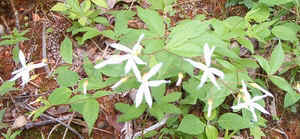 |
Common Name: Fawn's Breath, Indian-Physic, Bowman's Root,
False American Ipecac
Scientific Name: Gillenia trifoliata
Family: Rosaceae
White Oak Mountain
Polk County, North Carolina
May 8, 2002
 |
The 3 leaflets and the 5 linear, slightly twisted, and unequal petals help identify this open, branching perennial that grows to a height of 2 - 3 feet. The roots are purgative. A native found primarily in the Atlantic Coast states from our area northward, Gillenia grows in the rich woods of the North Carolina mountains and northern piedmont. April - June [Justice, William S. and Bell, C. Ritchie, Wild Flowers of North Carolina. University of North Carolina Press, Chapel Hill, 1968]
The alternate leaves of the bowman's root are divided into three distinct parts, hence the Latin name trifoliatus. The three serrated leaflets are long and narrow. Two sharply pointed "mini leaves" called stipules mark the base of the leaves. The flower's five twisted white petals are of uneven length, lending the plant a somewhat tattered appearance. The petals radiate from a central tube covered by a pinkish calyx. Inside are 20 stamens and five pistils. These flowers are loosely grouped into a many-branched inflorescence called a panicle. Common names include Indian-physic and American ipecac, because the crushed root induced vomiting. April - June [White, Peter, Wildflowers of the Smokies. Great Smoky Mountains Natural History Association, Gatlinburg, 1996]
This erect plant has white or pinkish 1 1/2-inch-wide flowers with five narrow, scraggly petals. The nearly stalkless leaves are divided into three leaflets, which are 2 to 4 inches long and toothed. The powdered root of this plant was long used by Indians and early settlers as a laxative. In fact, in some areas it is still known as Indian-physic. The origin of the name "bowman's-root" is unclear. The term "bowman" might well refer to the man at the bow of a boat. On the other hand, it might refer to an Indian, the man with a bow. In either case, the bowman had some sort of relationship with this plant's roots. Bowman's-root grows in rich wooded areas throughout the mountains of North Carolina and Virginia. April - June [Alderman, J. Anthony, Wildflowers of the Blue Ridge Parkway. The University of North Carolina Press, Chapel Hill, 1997]
The rare American ipecac, Porteranthus stipulatus (Gillenia stipulata), has a similar flower; however, the leaves are divided into 5 segments. Each segment consists of 3 leaflets and 2 stipules that look like smaller leaflets. Tea made from both potentially toxic species of this genus has been used as a laxative and to induce vomiting. It is a common plant along the Blue Ridge Parkway, often growing so large and dense that it looks more a shrub than an herbaceous wildflower. April - August [Adams, Kevin and Casstevens, Marty, Wildflowers of the Southern Appalachians: How to Photograph and Identify Them. John F. Blair, Publisher, Winston-Salem, 1996]
January February March April May June July August September October November December
Alphabetical Listings -- A B C D, E F G H I, J, K L M N, O P Q, R S T U, V W X, Y, Z
Family Listings -- A B C D, E F G H I, J, K L M N, O P Q, R S T U, V W X, Y, Z
Genus Listings -- A B C D, E F G H I, J, K L M N, O P Q, R S T U, V W X, Y, Z